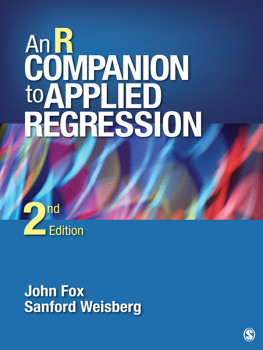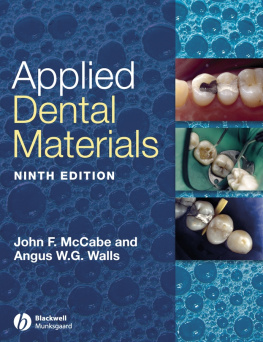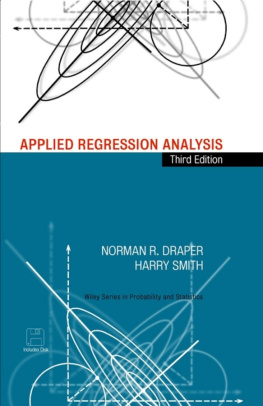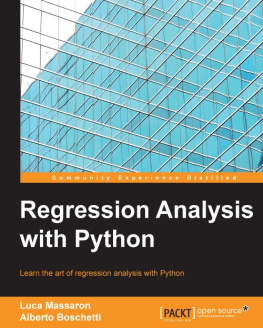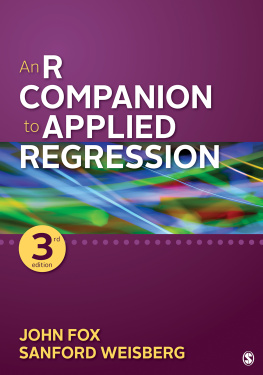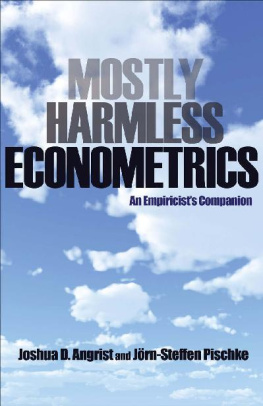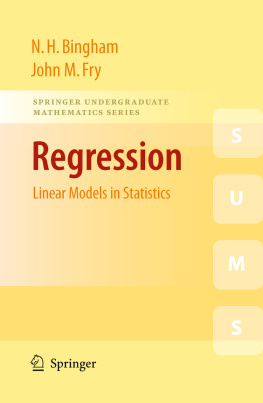John Fox - An R Companion to Applied Regression
Here you can read online John Fox - An R Companion to Applied Regression full text of the book (entire story) in english for free. Download pdf and epub, get meaning, cover and reviews about this ebook. year: 2010, publisher: SAGE Publications, genre: Computer. Description of the work, (preface) as well as reviews are available. Best literature library LitArk.com created for fans of good reading and offers a wide selection of genres:
Romance novel
Science fiction
Adventure
Detective
Science
History
Home and family
Prose
Art
Politics
Computer
Non-fiction
Religion
Business
Children
Humor
Choose a favorite category and find really read worthwhile books. Enjoy immersion in the world of imagination, feel the emotions of the characters or learn something new for yourself, make an fascinating discovery.
- Book:An R Companion to Applied Regression
- Author:
- Publisher:SAGE Publications
- Genre:
- Year:2010
- Rating:5 / 5
- Favourites:Add to favourites
- Your mark:
- 100
- 1
- 2
- 3
- 4
- 5
An R Companion to Applied Regression: summary, description and annotation
We offer to read an annotation, description, summary or preface (depends on what the author of the book "An R Companion to Applied Regression" wrote himself). If you haven't found the necessary information about the book — write in the comments, we will try to find it.
John Fox: author's other books
Who wrote An R Companion to Applied Regression? Find out the surname, the name of the author of the book and a list of all author's works by series.
An R Companion to Applied Regression — read online for free the complete book (whole text) full work
Below is the text of the book, divided by pages. System saving the place of the last page read, allows you to conveniently read the book "An R Companion to Applied Regression" online for free, without having to search again every time where you left off. Put a bookmark, and you can go to the page where you finished reading at any time.
Font size:
Interval:
Bookmark:
An R
COMPANION
to APPLIED
REGRESSION

To the memory of my parents, Joseph and Diana
J. F.
For my teachers, and especially Fred Mosteller, who I think would have liked this book
S. W.
An R
COMPANION
to APPLIED
REGRESSION

John Fox
McMaster University
Sanford Weisberg
University of Minnesota

Copyright 2011 by SAGE Publications, Inc.
All rights reserved. No part of this book may be reproduced or utilized in any form or by any means, electronic or mechanical, including photocopying, recording, or by any information storage and retrieval system, without permission in writing from the publisher.
For information:
 | SAGE Publications, Inc. 2455 Teller Road Thousand Oaks, California 91320 E-mail: | SAGE Publications India Pvt. Ltd. B 1/I 1 Mohan Cooperative Industrial Area Mathura Road, New Delhi 110 044 India |
| SAGE Publications Ltd. 1 Olivers Yard 55 City Road, London EC1Y 1SP United Kingdom | SAGE Publications Asia-Pacific Pte. Ltd. 33 Pekin Street #02-01 Far East Square Singapore 048763 |
Printed in the United States of America
Library of Congress Cataloging-in-Publication Data
Fox, John, 1947
An R companion to applied regression. 2nd ed./John Fox, Sanford Weisberg.
p. cm.
Rev. ed. of: An R and S-Plus companion to applied regression. c2002.
Includes bibliographical references and index.
ISBN 978-1-4129-7514-8 (pbk.)
1. Regression analysisData processing. 2. R (Computer program language) I. Weisberg, Sanford, 1947- II. Fox, John, 1947- R and S-Plus companion to applied regression. III. Title.
QA278.2.F628 2011
519.5'3602855133dc22
2010029245
This book is printed on acid-free paper.
10 11 12 13 14 10 9 8 7 6 5 4 3 2 1
Acquisitions Editor: | Vicki Knight |
Associate Editor: | Lauren Habib |
Editorial Assistant: | Kalie Koscielak |
Production Editor: | Brittany Bauhaus |
Permissions Editor: | Adele Hutchinson |
Copy Editor: | QuADS PrePress (P) Ltd. |
Typesetter: | C&M Digitals (P) Ltd. |
Proofreader: | Charlotte J. Waisner |
Cover Designer: | Candice Harman |
Marketing Manager: | Dory Schrader |
Preface
T his book aims to provide a broad introduction to the R statistical computing environment (R Development Core Team, 2009a) in the context of applied regression analysis, which is typically studied by social scientists and others in a second course in applied statistics. We assume that the reader is learning or is otherwise familiar with the statistical methods that we describe; thus, this book is a companion to a text or course on modern applied regression, such as, but not necessarily, our own Applied Regression Analysis and Generalized Linear Models, second edition (Fox, 2008) and Applied Linear Regression, third edition (Weisberg, 2005). Of course, different texts and courses have somewhat different content, and if you encounter a topic that is unfamiliar or that is not of interest, feel free to skip it or to pass over it lightly. With a caveat concerning the continuity of examples within chapters, the book is designed to let you skip around and study only the sections you need.
The availability of cheap, powerful, and convenient computing has revolutionized the practice of statistical data analysis, as it has revolutionized other aspects of our society. Once upon a time, but well within living memory, data analysis was typically performed by statistical packages running on mainframe computers. The primary input medium was the punchcard, large data sets were stored on magnetic tapes, and printed output was produced by line printers; data were in rectangular case-by-variable format. The job of the software was to combine instructions for data analysis with a data set to produce a printed report. Computing jobs were submitted in batchmode, rather than interactively, and a substantial amount of timehours, or even dayselapsed between the submission of a job and its completion.
Eventually, batch-oriented computers were superseded by interactive, timeshared, terminal-based computing systems and then successively by personal computers and workstations, networks of computers, and the Internetand perhaps in a few years by cloud computing. But some statistical software still in use traces its heritage to the days of the card reader and line printer. Statistical packages, such as SAS and IBM SPSS,
The package model of statistical computing can work well in the application of standard methods of analysis, but we believe that it has several serious drawbacks, both for students and for practitioners of statistics. In particular, we think that the package approach of submitting code and getting output to decipher is not a desirable pedagogical model for learning new statistical ideas, and students can have difficulty separating the ideas of data analysis that are under study from the generally rigid implementation of those ideas in a statistical package. We prefer that students learn to request specific output, examine the result, and then modify the analysis or seek additional output. This feedback loop of intermediate examination forces students to think about what is being computed and why it is useful. Once statistical techniques are mastered, the data-analytic process of inserting the intelligence of the user in the middle of an analysis becomes second naturein our view, a very desirable outcome.
The origins of R are in the S programming language, which was developed at Bell Labs by experts in statistical computing, including John Chambers, Richard Becker, and Allan Wilks (see, e.g., Becker et al., 1988, Preface). Like most good software, S has evolved considerably since its origins in the mid-1970s. Although Bell Labs originally distributed S directly, it is now available only as the commercial product S-PLUS. R is an independent, open-source, and free implementation of the S language, developed by an international team of statisticians, including John Chambers. As described in Ihaka and Gentleman (1996), what evolved into the R Project for Statistical Computing was originated by Ross Ihaka and Robert Gentleman at the University of Auckland, New Zealand. A key advantage of the R system is that it is freesimply download and install it, as we will describe shortly, and then use it.
R is a statistical computing environment and includes an interpreter, with which the user-programmer can interact in a conversational manner. R is one of several statistical programming environments; others include Gauss, Stata, and Lisp-Stat (which are described, e.g., in Stine and Fox, 1996).
If you can master the art of typing commands, a good statistical programming environment allows you to have your cake and eat it too. Routine data analysis is convenient, but so are programming and the incorporation of new statistical methods. We believe that R balances these factors especially well:
Next pageFont size:
Interval:
Bookmark:
Similar books «An R Companion to Applied Regression»
Look at similar books to An R Companion to Applied Regression. We have selected literature similar in name and meaning in the hope of providing readers with more options to find new, interesting, not yet read works.
Discussion, reviews of the book An R Companion to Applied Regression and just readers' own opinions. Leave your comments, write what you think about the work, its meaning or the main characters. Specify what exactly you liked and what you didn't like, and why you think so.

